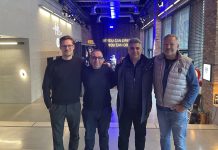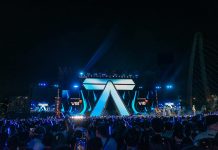Months before hundreds of thousands of attendees descended on Riyadh, Saudi Arabia, for Soundstorm 2023, the team at PRG was busy planning the rigging, audio, lighting, and video networks for the biggest of the eight stages on-site.
Named “Big Beast”, the stage featured one of the largest LED screens on the planet, measuring a staggering 189 metres wide by 43 metres high: over 200 million pixels broken up into 28 UHDs. James Morden, PRG’s lead video engineer for the event, puts it in context: “If you’re in a big stadium, the pitch is about 100 metres long – imagine placing a screen on the pitch that goes through both goals, out of the stadium and into the parking lot, and sticks through the roof. Your brain can’t process it.”
Compared to previous years, the event’s production team aimed to simplify technical infrastructure, while maintaining top-quality performance for artists on stage. Recalling previous systems, Morden said: “Between the size limitations of canvasses for scaling and playback, we knew we needed a better solution. We had layers of scalers upon scalers, just to play out the resolution needed. Something as simple as switching a signal became a such a mission.”
After weeks of research, PRG sent a small team to meet with the PIXERA team at AV Stumpfl’s Austrian HQ. “We knew on paper it would work, so the purpose of the trip was to first meet the team, and secondly to test our ingest and scaling plan,” Morden continued.
He noted one of the key points in their testing was latency: “It’s a festival: any artist can turn up with their show running on their own hardware, and we needed to plug that into the system, and get it scaled, sliced and diced.” Using high-speed cameras, the team clocked three frames of latency from a signal hitting the input card on the PIXERA four to the time it rendered on the output. Satisfied with the results of their testing, PRG endorsed a PIXERA-only solution with full redundancy to PRG’s clients. “It did exactly what it said it would. It sliced and diced, it scaled – it didn’t matter what we threw at it,” recalled Morden.
Before PRG was able to finalise the system design for the show, the planned use of PIXERA needed to be approved by a number of key stakeholders: the end client, MDLBEAST, as well as its production management, Bill Leabody and Andy Head; plus the team at Production Glue and Visual Noise Creative. “That is quite a lot of conversations and meetings to suggest a change, plus a good amount of trust or faith in both our recommendation and AV Stumpfl’s ability to deliver a fully working platform at this untried scale,” Morden explained. “We’re grateful to everyone involved for making the process so smooth.”
PRG’s final Soundstorm 2023 system comprised 12 AV Stumpfl PIXERA four RS servers (including spare render servers), two PIXERA two servers, and three PIXERA Director servers. Commenting on the reliability of the PIXERA solution, Morden commented: “We were live for two and a half weeks and never once switched to a backup.”
Since the same server hardware handled all Notch effects, PRG needed less rack space and less cable complexity (both of which in turn lowered the freight bill), required less power, had a smaller crew on site, and had a more flexible video system. This meant that in spite of using a video playout platform capable of more pixels (the previous year’s only had 22 UHDs’ worth), Soundstorm 2023’s system would actually cost less than 2022 – yet another client-friendly feature.
Additionally, PRG furnished an offline server for creative teams to programme their content prior to taking the stage. “Tom Denney, who had been out with Metallica for most of 2023, reprogrammed their touring show on PIXERA and had it looking really good for the opening night. All their content was 1:1, so we didn’t have to scale a thing,” Morden noted, “and you were able have multiple Notch blocks loaded across that entire canvas and fade between them – that was a mindset adjustment for Tom and the rest of us. Plus, because of Multi-User, we could monitor CPU and GPU stats up on another Director machine. We never once dropped a frame.”
Come December 2023, neither sync nor scale were sacrificed. Attendees were wowed at 28 UHDs strobing in perfect sync, reported Morden: “We got a lot of feedback from all the artists’ camps. Usually, festivals have a backdrop and two IMAGs – three simple screens to plug in to. Anything beyond that, you’re going through scaling, which adds latency. So, all the feedback was around the speed of response: it was five frames from leaving your laptop to being on the screen, allowing for ingest, processing, and scaling. Running the Riyadh system at 50fps, that’s 1/10th of a second – that’s impressive, and, ultimately, helps the creative people be creative – they can press the buttons at the right time and not have to pre-empt by a fraction of a beat.”
PRG’s Big Beast video crew saw a lot of foot traffic backstage, not just from the artists in town for the event, but also from the production companies responsible for the other seven Soundstorm stages. “They sometimes want to talk about the overall design, but they’re usually more interested in how we’ve made it work. We’ve been really open about it,” he said, “There is no panacea, no universal solution, but on these exa-scale, high-quality shows, you want a flexible and fully redundant system,” Morden concluded, “and PIXERA more than delivered. I’m looking forward to building on this base for 2024.”





